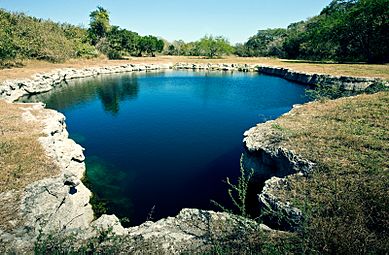Zacatón facts for kids
Zacatón is a giant, water-filled hole in the ground, also known as a sinkhole. It's part of a group of amazing natural features found in Aldama Municipality, near the Sierra de Tamaulipas mountains in northeastern Tamaulipas, Mexico.
Zacatón is special because it's the deepest known water-filled sinkhole in the world! It goes down about 339 meters (1,112 ft) (that's like a 100-story building!). An underwater robot measured the water part to be 319 meters (1,047 ft) deep.
The name Zacatón comes from the "zacate" grass. This grass forms islands that float freely on the water's surface and move around with the wind.
Scientists have even found new types of bacteria living on the rock walls deep inside Zacatón.
Diving into Zacatón
Because it's so deep, El Zacatón has been an important place for divers to explore:
- In 1993, Dr. Ann Kristovich set a world record for women by diving 169 m (554 ft) into the sinkhole.
- On April 6, 1994, two famous divers, Jim Bowden and Sheck Exley, tried to reach the very bottom. Jim Bowden set a new men's world record by diving 282 m (925 ft) deep. Sadly, during this very challenging dive, Sheck Exley passed away.
- NASA used Zacatón as a testing ground for a special robot called the Deep Phreatic Thermal Explorer (DEPTHX). This robot was being developed to explore places like Europa, one of Jovian's moons, which might have oceans under its ice. The DEPTHX robot was built by Stone Aerospace with help from several universities and research groups.
How Zacatón Formed
Zacatón is just one of many sinkholes and other cool rock formations in this area. There are more than 15 sinkholes, several cave systems, and springs with caves. Some of these sinkholes even have strange "lids" made of rock over them, with water trapped underneath.
Since the late 1990s, Dr. Marcus Gary, a scientist who studies water and rocks, has been studying Zacatón. He wants to understand how these sinkholes formed and how they change over time. He used many tools, including the DEPTHX robot, to explore the deepest parts of Zacatón for the first time.
Dr. Gary believes these sinkholes started forming a very long time ago, during the Pleistocene Ice Age. He thinks that volcanic activity deep underground made the water slightly acidic. This acidic water slowly dissolved the limestone rock above it, creating hollow spaces. This process is called "hypogenic karstification." Over time, the rock above these hollow spaces would collapse, creating the deep shafts we see today.
Another interesting thing about these sinkholes is that some of them seem to be closing up at the top. A type of rock called travertine (which is a form of calcium carbonate) forms crusts on their surfaces. It's like a skin forming on top of the water. This process takes thousands of years. One sinkhole, Poza Seca, seems to have closed up completely, sealing off an underwater lake. Scientists think that if there's life in such a sealed-off lake, it would be bacteria that can live without oxygen and sunlight. These life forms could be very different from anything we've ever found!
See also
 In Spanish: El Zacatón para niños
In Spanish: El Zacatón para niños
- Cenote
- DEPTHX
- List of sinkholes of Mexico






